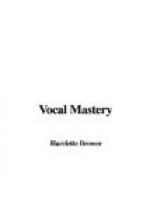KNOWLEDGE OF ANATOMY
“While I believe in understanding one’s anatomy sufficiently for proper tone production, and all that goes with it, there are many peculiar and unnecessary fads and tricks resorted to by those who call themselves teachers of singing. The more fantastic the theories inculcated by these people, the more the unwary students seem to believe in them. People like to be deluded, you know. But I am not able to gratify their desires in this direction; for I can’t lie about music!
“I was present at a vocal lesson given by one of these so-called instructors. ’You must sing in such a way that the tone will seem to come out of the back of your head,’ he told the pupil, and he waved his arms about his head as though he were drawing the tone out visibly. Another pupil was placed flat on his back, then told to breathe as though he were asleep, and then had to sing in that position. Another teacher I know of makes pupils eject spit-balls of tissue paper at the ceiling, to learn the alleged proper control of the breath. What criminal nonsense this is!
“As I have said, I believe in knowing what is necessary about anatomy, but not in too great measure. A new book will soon be issued, I am told, which actually dissects the human body, showing every bone and muscle in any way connected with breath or voice. All this may be of interest as a matter of research, but must one go into such minutiae in order to teach singing? I think the answer must ever be in the negative. You might as well talk to a gold-fish in a bowl-and say: ’If you desire to proceed laterally to the right, kindly oscillate gently your sinister dorsal fin, and you will achieve the desired result.’ Oh, Art, what sins are committed in thy name!”
IN THE STUDIO
It is often affirmed that an artist finds experience the best teacher. It must be equally true that the artist-teacher of wide experience in both performance and instruction, should be a safe guide, just because of this varied experience.
I was impressed with this fact when I recently had the privilege of visiting Mr. Bispham’s studio during lesson hours, and listening to his instruction. A most interesting sanctum is this studio, filled as it is with souvenirs and pictures of the artist’s long career on the operatic stage. Here hangs a drawing in color of Bispham as Telramund, in shining chain armor; there a life-size portrait as “Beethoven,” and again as himself. In the midst of all is the master, seated at a table. In front of him, at the piano, stands the student. It is an English song she is at work on, for Mr. Bispham thoroughly believes in mastering English as well as other languages.
How alert he is as he sits there; how keen of eye and ear. Not the slightest fault escapes him. He often sings the phrase himself, then calls for its repetition.




